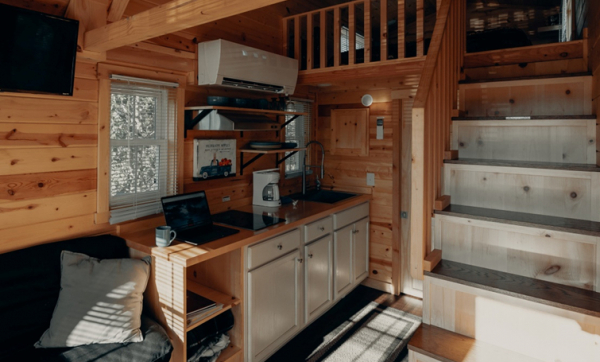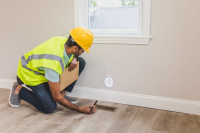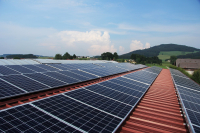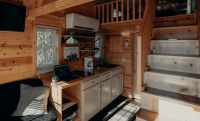So, this is not an apples-to-apples comparison because these weak objections have nothing to do with the residential log cabin's credibility, quality, and utility. The misunderstanding comes in choosing the right one for the right use at the right time. If you think this task is technical, I'm afraid you'll be unable to retain this opinion after reading the crucial tips I've jotted down for you in choosing the right residential log cabins.
P.S: In choosing, I have included both choices: building or buying the built residential log cabins.
I've divided the decision-making process into two parts: Decisions you should take before building or buying residential log cabins and decisions you should make during building or buying them.
1- Before building or buying residential log cabins, decide:
(a) Budget
In choosing a residential log cabin, either building yourself or planning to buy a ready-made residential log cabin or, at minimum, a log home kit, your budget will be central in your decision. Your surplus money or budget will guide you in choosing the type and size of your residential log cabin. Consider the points below when going for any one of these three commitments:
If you are buying built residential log cabins, close check the wood quality and insulation abilities, not to mention inner space.
Never fall prey to deceptive low prices you encounter initially. There are many chances that either they might be low-quality houses or might brand low prices, but when you calculate the amount per m2, they turn out pretty high.
If you are confused about building the type of house, your budget can guide can better. Having a high budget, you should build residential log cabins made of natural wood used by traditional qualities, glued efficiently by expert-having high insulation. You can make or buy a glued-beam residential house for a living if you have a low budget.
If you're planning to choose a log kit for your home, your house price will be roughly two to three times the price of the log cabin kit you choose.
(b) Purpose
Residential log cabins offer comfort, comeliness, and serendipity. We know this is one of the reasons you are leaning toward log homes. Along with this, I want you to ensure that you should have clarity about the use of residential log cabins. For instance, they have wide usage as the home office, social space, gym space, workspace, or permanent residence.
Having clarity of purpose is indispensable because you will have answers to many questions regarding the choice of the residential log cabin. For example, if you're choosing it solely for your permanent residence, a single bedroom having a bath and a kitchen will suffice, but if you're going to stay there for a few days in a month or year, you may not need a kitchen. You may go for a four-bedroom log cabin in case of a large family. So, clarity of purpose is the key.
Besides, a clearly defined purpose helps to decide the design and whether you need planning permission or not.
(c) Size
After concluding your budget and purpose, the next step will be deciding the size of residential log cabins.
- ● If you're planning to live with your family (including children), family size will be chief in choosing the size of the residential log cabin you are about to buy or build.
- ● If you want to have it for work or gym, the size would be according to the space the concerned equipment or material comprises.
So, your use of your log home decides the size of it when building it. When you buy the log home, be vigilant about the technical dimensions they tell you about the size of the log home. For example, the seller counts the areas covered by a roof overhanging the size of the residential log cabin, but in your mind, you might think of the wall as the end limit.
2- During building or buying the log home, decide:
(a) Wood quality
In residential log cabins, if someone overlooks the essential characteristics of timber in ordering or asking about them while buying a log cabin, I'm afraid it will be a risky investment. So, I would recommend you to go for slow-grown timber first. Prudence is that this wood has less risk of splitting. Besides, its durability is higher, and at the same, the time has high density. It will positively impact your residential log cabin's appearance and longevity.
P.S: Choose solid and long structured timber in the walls instead of many small logs notched together for your log cabin.
(b) Doors and Windows
When building or ordering your residential log cabin, be purpose-oriented in choosing the style of windows and doors. So, their formation and manufacturing should create ease in your lifestyle. For example:
- ● Your windows and door should allow maximum sunlight in your cabin when required.
- ● If you're a party person, they should have an open area partitioned.
- ● If you want to retain more heat inside, your windows and doors should be double-glazed.
Also, never forget to re-check the quality of wood and glass in the windows and doors yourself. Do not fall prey to those who ask you to glaze windows yourself. Ask them to do it.
(c) Floor and Roof
In buying log cabins, the buyer should analyze the quality and material used on the floor.
In giving strength and longevity to the log cabin, one should be vigilant in choosing roof joists and gables. The type of roof chosen should be according to one's climate and need. The apex roof is more of a traditional style, and the pent roof gives a modern look. The third type, the off-set apex roof, is a mixture of the former roof types and covers qualities of both. Whatever style you choose in building or buying your residential log cabin, make sure it has strong wood to give better protection and insulation.








































